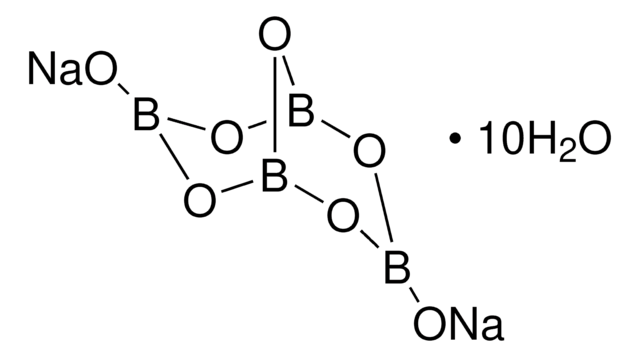15663
Ácido bórico
BioUltra, for molecular biology, ≥99.5% (T)
About This Item
Productos recomendados
grado
for molecular biology
Nivel de calidad
presión de vapor
2.6 mmHg ( 20 °C)
Línea del producto
BioUltra
Ensayo
≥99.5% (T)
Formulario
powder or crystals
técnicas
DNA purification: suitable
RNA purification: suitable
impurezas
DNases, none detected
RNases, none detected
insoluble matter, passes filter test
phosphatases, none detected
proteases, none detected
<0.05% non-volatile substances in MeOH/HCl
pérdida
≤0.5% loss on drying, 20 °C (HV)
pH
3.6-4.4 (25 °C, saturated solution in H2O)
mp
160 °C (dec.) (lit.)
solubilidad
H2O: 1 M, clear, colorless (hot)
densidad
1.49 g/cm3 at 23 °C
trazas de anión
chloride (Cl-): ≤5 mg/kg
phosphate (PO43-): ≤5 mg/kg
sulfate (SO42-): ≤5 mg/kg
trazas de catión
Al: ≤5 mg/kg
As: ≤0.5 mg/kg
Ba: ≤5 mg/kg
Bi: ≤5 mg/kg
Ca: ≤10 mg/kg
Cd: ≤5 mg/kg
Co: ≤5 mg/kg
Cr: ≤5 mg/kg
Cu: ≤5 mg/kg
Fe: ≤5 mg/kg
K: ≤50 mg/kg
Li: ≤5 mg/kg
Mg: ≤5 mg/kg
Mn: ≤5 mg/kg
Mo: ≤5 mg/kg
Na: ≤50 mg/kg
Ni: ≤5 mg/kg
Pb: ≤5 mg/kg
Sr: ≤5 mg/kg
Zn: ≤5 mg/kg
cadena SMILES
OB(O)O
λ
1 M in H2O
Absorción UV
λ: 260 nm Amax: 0.015
λ: 280 nm Amax: 0.010
InChI
1S/BH3O3/c2-1(3)4/h2-4H
Clave InChI
KGBXLFKZBHKPEV-UHFFFAOYSA-N
¿Está buscando productos similares? Visita Guía de comparación de productos
Aplicación
Otras notas
Palabra de señalización
Danger
Frases de peligro
Consejos de prudencia
Clasificaciones de peligro
Repr. 1B
Código de clase de almacenamiento
6.1D - Non-combustible acute toxic Cat.3 / toxic hazardous materials or hazardous materials causing chronic effects
Clase de riesgo para el agua (WGK)
WGK 1
Punto de inflamabilidad (°F)
Not applicable
Punto de inflamabilidad (°C)
Not applicable
Equipo de protección personal
Eyeshields, Gloves, type P3 (EN 143) respirator cartridges
Elija entre una de las versiones más recientes:
¿Ya tiene este producto?
Encuentre la documentación para los productos que ha comprado recientemente en la Biblioteca de documentos.
Los clientes también vieron
Nuestro equipo de científicos tiene experiencia en todas las áreas de investigación: Ciencias de la vida, Ciencia de los materiales, Síntesis química, Cromatografía, Analítica y muchas otras.
Póngase en contacto con el Servicio técnico







